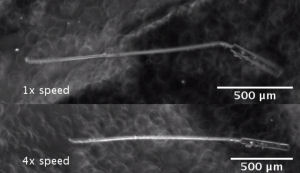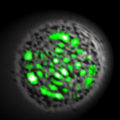
The self-organization properties of DNA-like molecular fragments four billion years ago may have guided their own growth into repeating chemical chains long enough to act as a basis for primitive life, say an international team of scientists from the University of Colorado Boulder and the University of University of Milan. A paper describing the intriguing research has been published in Nature Communications.
While studies of ancient mineral formations contain evidence for the evolution of bacteria from 3.5 to 3.8 billion years ago – just half a billion years after the stabilization of Earth’s crust – what might have preceded the formation of such unicellular organisms is still a mystery. The new findings suggest a novel scenario for the non-biological origins of nucleic acids, which are the building blocks of living organisms, explained CU-Boulder physics Professor Noel Clark, a study co-author.
The discovery in the 1980s of the ability of RNA to chemically alter its own structure led to the concept of an “RNA world” in which primordial life was a pool of RNA chains capable of synthesizing other chains from simpler molecules available in the environment. While there now is consensus among origin-of-life researchers that RNA chains are too specialized to have been created as a product of random chemical reactions, the new findings suggest a viable alternative, Clark argues.
The new research demonstrates that the spontaneous self-assembly of DNA fragments just a few nanometers in length into ordered liquid crystal phases has the ability to drive the formation of chemical bonds that connect together short DNA chains to form long ones, without the aid of biological mechanisms. Liquid crystals are a form of matter that has properties between those of conventional liquids and those of a solid crystal – a liquid crystal may flow like a liquid, for example, but its molecules may be oriented more like a crystal.
“Our observations are suggestive of what may have happened on the early Earth when the first DNA-like molecular fragments appeared,” said Clark.
For several years the research group has been exploring the hypothesis that the way in which DNA emerged in the early Earth lies in its structural properties and its ability to self-organize. In the pre-RNA world, the spontaneous self-assembly of fragments of nucleic acids (DNA and RNA) may have acted as a template for their chemical joining into polymers, which are substances composed of a large number of repeating units.
“The new findings show that in the presence of appropriate chemical conditions, the spontaneous self assembly of small DNA fragments into stacks of short duplexes greatly favors their binding into longer polymers, thereby providing a pre-RNA route to the RNA world,” said Clark.
Related:
Discuss this article in our forum
Comet smash simulations hint at life’s cosmic origins
Clay bubbles may have nurtured self-organizing precursors to life
Knocking on the door of life: Self-replicating RNA synthesized
Clay May Have Been Catalyst For Life








Comments are closed.